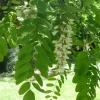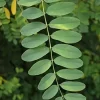X
CONTACT US
Great Lakes Center, SAMC 319
SUNY Buffalo State
1300 Elmwood Ave., Buffalo, NY 14222
wnyprism@buffalostate.edu
(716) 878.4708
SUBSCRIBE TO LISTSERV
FOLLOW US
CONTACT
Black Locust
COMMON NAME:
Black locustSCIENTIFIC NAME:
Robinia pseudoacaciaORIGIN:
Appalachian Mountains (southeast U.S.)DESCRIPTION:
Black locust is a fast growing tree that can grow to be 40-100 ft. tall. It has alternate, compound leaves with 7-21 oval-shaped leaflets per leaf. Pairs of thorns are found at the base of each leaf. Throughout May and June it produces clonal, drooping clusters of fragrant white flowers. In September, the black locust fruit mature into 2-4" long seed pods, which will remain on the tree into winter.HABITAT:
Black locust is an early-successional plant, preferring full sun and rocky, or sandy, soils. As a legume, this tree can thrive and grow rapidly in nitrogen-deficient soils. Black locust are most often found in abandoned fields, prairies, woodlands, stream banks and roadsides.THREAT:
Black locusts threaten prairies, savannahs and upland forests. They have an extensive root system that allows them to reproduce clonally, sprouting many clones in one area. As they grow, they'll form islands of dense canopy which shade out any plants below them.MANAGEMENT:
Cutting and mowing are ineffective methods for killing black locust. Systemic herbicides should be applied to the cut stumps of every black locust stump in a clone. Treated stumps may appear to be killed but re-sprout years after treatment, so follow-up monitoring and treatments are required for several years.
WNY PRISM PRIORITY:
- Tier 4 - Local Control
- NYS Invasive Species Tiers Chart
ADDITIONAL RESOURCES:
- Native Alternatives
- Bitternut hickory (Carya cordiformis)
- Shagbark hickory (Carya ovata)
- Tulip tree (Liriodendron tulipifera)
NYS Prohibited and Regulated Species - Part 575:
Black locust is a regulated species in New York State - for more information on Prohibited and Regulated Species, visit http://www.dec.ny.gov/animals/99141.html.
PATHWAYS OF INVASION:
REGIONAL DISTRIBUTION:
Common
MAP (via iMapInvasives):
This map shows confirmed observations (green points) submitted to the NYS Invasive Species Database. Absence of data does not necessarily mean absence of the species at that site, but that it has not been reported there. For more information, please visit iMapInvasives.





